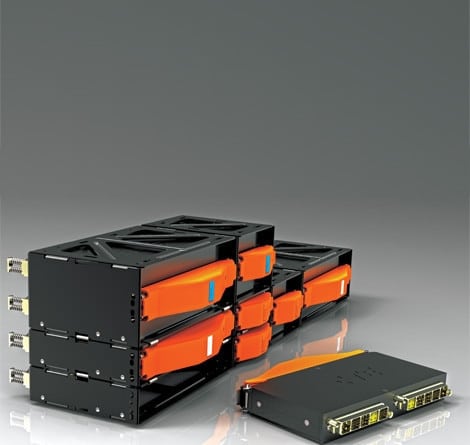
TE Connectivity’s new miniature modules for aircraft cabin systems packaging. Photo courtesy of TE Connectivity
An Airbus-lead avionics standards-making committee is developing a new concept designed to significantly reduce the size and expense of installing and upgrading aircraft electronics. The goal of SAE ITC’s ARINC Industry Activities cabin systems subcommittee is to publish an extension of an existing standard for mini modular rack principle (MiniMRP) avionics packaging, ARINC 836A.
ARINC 836A would be an update to the original ARINC 836. Published in 2012, 836 provided a standardized approach to the use of cabling, connectors, grounding and bonding methods for installing and packaging aircraft cabin systems components.
Until the development of that standard, aircraft cabin equipment was typically installed individually along the ceiling area of the fuselage using customized cabling and provisions, which often lead to long lead times and excessive costs. ARINC 836 would resolve that by providing a simplified routing concept for electrical connection of equipment and improved accessibility to installation areas.
The new standard would take the modular rack principle and recognize trends within commercial-off-the-shelf (COTS) electronics, which continue to become smaller and more compact. The new standard would also introduce the concept of the use of miniature modules as packaging for computing components that support cabin system functionality, such as in-flight entertainment, lighting and temperature control.
Engineers from Delta Air Lines, Airbus and Boeing are leading the development of the new standard, also known as MiniMRP. Suppliers including Panasonic, Thales and TE Connectivity are also supporting the development effort.
“The main adoption will take a couple of years,” Frederik Morel, senior product manager at TE Connectivity’s Belgium integrated systems and cable assemblies division told Avionics. “MiniMRP will provide significant change to the architecture of today’s aircraft, and that’s not something that happens overnight. It’s going to gradually find its way onto aircraft through less critical applications like in-flight entertainment.”
At the 2017 Paris Air Show, TE Connectivity’s exhibit featured mock cabin setups of the use of the MiniMRP concept, using standardized thin boxes packed with computing power at fixed points, serving as nodes along a fiber optic network within an airframe. Its vision is to use the new standardized packaging size to give systems integrators and avionics OEMs the ability to quickly add and remove capabilities throughout the cabin.
The company believes the new boxes would reduce avionics packaging size by up to 40%. Morel believes MiniMRP will help future airframe designs to rely less on point-to-point wiring and shift more toward the use of fiber optic network where new functionality can be easily integrated into an existing network using the smaller avionics packaging.
According to Paul Prisaznuk, program director for ARINC standards development for the Airlines Electronic Engineering Committee (AEEC), the cabin systems committee is working on ARINC Project Paper 836A to establish new miniature modules for cabin equipment packaging. This will include four new cabin systems module form factors to support weights ranging from a few ounces to a maximum of six pounds.
The 836A project paper could become an industry accepted standard by April 2018, when avionics engineers gather for the annual AEEC/AMC conference in Dallas, Texas.